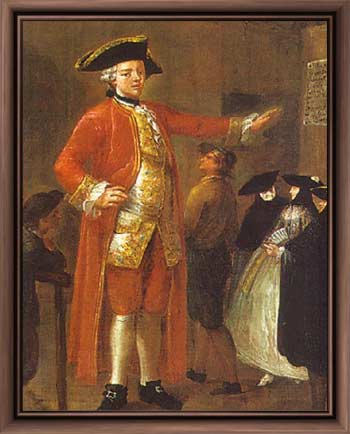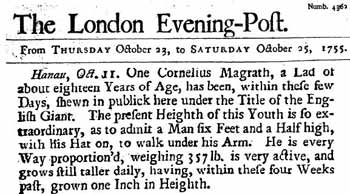The skeleton of Cornelius Magrath, the ‘Tipperary Giant,’ will be one of the exhibits on display in an exhibition, marking 300 years of medicine, at Dublin’s Trinity College, over the coming weeks.
The parents and siblings of Cornelius, who was born near the Silvermines, Nenagh, Co Tipperary, were people of ordinary stature, but Cornelius, as he turned 15 years old, became seized with pains in his limbs and in the space of one year grew some 21 inches in stature.
In July, 1752, when just 16 years old, Cornelius Magrath, (Born March 1736) went to Youghal, Co.Cork, to receive saltwater treatment. Latter was a cure to alleviate his growing pains. Here large crowds of individuals, began to take a curious interest in this giant.
While in Youghal, the then Bishop of Cloyne, Dr George Berkery, who died in 1753, took a keen interest in the young boys health, keeping him in his home and assisting him in his recovery.
By this time Cornelius’s hands, we are told, had grown to the size of “a shoulder of mutton, while his shoes measured some 15 inches.‘ His appetite was considered quite moderate and he drank cider with his meals, to assist in alleviating his growing pains.
The London Magazine in August 1752 states (Headlined Cork July 24th) “There is now in this city one Cornelius McGrath, boy of 15 years, 11 months old, of a most gigantic stature, being 7 feet 9 inches three quarter high. He is clumsily made, talks boyish and simple, he comes hither from Youghal, where he has been a year going into the salt water for rheumatic pains which almost cripple him…”
It was while in Youghal, Co.Cork, that he was persuaded to show himself off in return for money, so he headed to London in 1753 to launch his career and was first exhibited in Bristol.
In an English issue of the then “Daily Advertiser” newspaper dated January 31st 1753, his sponsors ran the following notice: “Just arrived in this city, from Ireland, the youth, mentioned lately in the newspapers, as the most extraordinary production in nature. He is allowed by the nobility and gentry, who daily resort to see him, to have the most stupendous and gigantic form (although a boy), and is the only representation in the world of the ancient and magnificent giants of that kingdom. He is seven feet three inches in height, without shoes. His wrist measures a quarter of a yard and an inch. He greatly surpasses Cajanus the Swede, in the just proportions of his limbs; and is the truest and best proportioned figure ever seen. He was sixteen years of age the 10th of last March and is to be seen at the ‘Peacock,’ at Charing Cross, from eight in the morning, till ten at night.”
Magrath went on from England to visit Paris and most of the larger cities in Europe, including Regensburg, on the northernmost part of the Danube river in Germany, in 1756, where his portrait was engraved by Johann Nepomuk Maag, beside a grenadier. At this time grenadiers were chosen because of their strength and height and would lead assaults in the field of battle, because of their large physique.
A Venetian artist, famous for painting contemporary scenes of life, Pietro Longhi, painted Cornelius, at the age of 20 years in 1757, part of a commission for the “Noble Gentleman Giovanni Grimandi dei Servi, Patrician of Venice.” The painting is entitled ” True Portrait of the Giant Cornelio Magrat, the Irishman.”
While in Flanders Magrath was forced to return to Ireland due to ill health.
Next we are informed by The London Intelligencer, of May 24th 1760, which reports: “Dublin May 20th. The 17th instant died in College – Green, Cornelius Mag, the man of gigantic stature, who has been for some time exhibited as a show in this city. He was but 23 years of age and measured while living 7 feet five inches high while stretched, he wanted but two inches of eight feet.” (Some reporter not too hot on the maths.)
Students, from nearby Trinity College, whom he had befriended, are believed to have stolen his body on the day he died. The students having dissected his body, preserved his bones and they still remain in Trinity College to this day.
Admission to this fine exhibition at Dublin’s Trinity College, will cost €9 for adults, and children under 12 years are admitted free of charge.



Leave a Reply